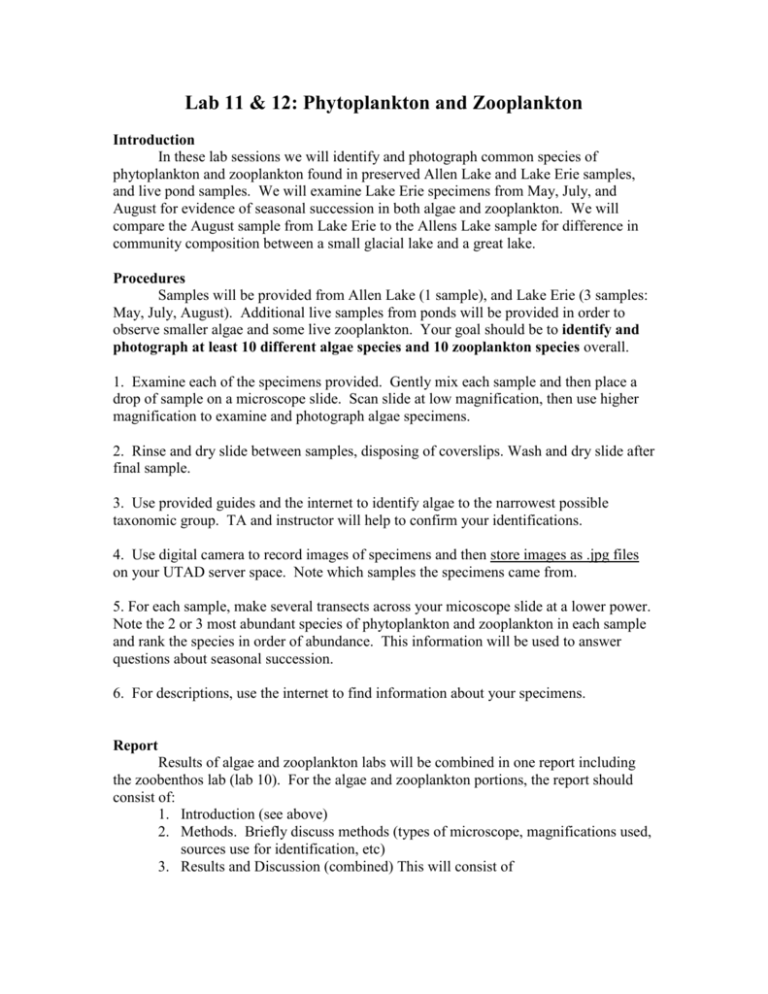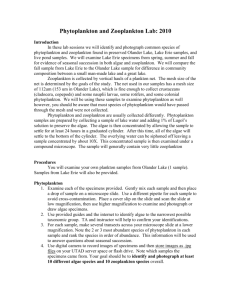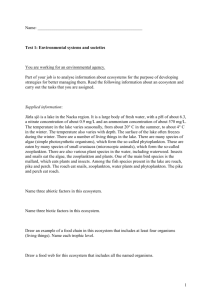handout
advertisement

Lab 11 & 12: Phytoplankton and Zooplankton Introduction In these lab sessions we will identify and photograph common species of phytoplankton and zooplankton found in preserved Allen Lake and Lake Erie samples, and live pond samples. We will examine Lake Erie specimens from May, July, and August for evidence of seasonal succession in both algae and zooplankton. We will compare the August sample from Lake Erie to the Allens Lake sample for difference in community composition between a small glacial lake and a great lake. Procedures Samples will be provided from Allen Lake (1 sample), and Lake Erie (3 samples: May, July, August). Additional live samples from ponds will be provided in order to observe smaller algae and some live zooplankton. Your goal should be to identify and photograph at least 10 different algae species and 10 zooplankton species overall. 1. Examine each of the specimens provided. Gently mix each sample and then place a drop of sample on a microscope slide. Scan slide at low magnification, then use higher magnification to examine and photograph algae specimens. 2. Rinse and dry slide between samples, disposing of coverslips. Wash and dry slide after final sample. 3. Use provided guides and the internet to identify algae to the narrowest possible taxonomic group. TA and instructor will help to confirm your identifications. 4. Use digital camera to record images of specimens and then store images as .jpg files on your UTAD server space. Note which samples the specimens came from. 5. For each sample, make several transects across your micoscope slide at a lower power. Note the 2 or 3 most abundant species of phytoplankton and zooplankton in each sample and rank the species in order of abundance. This information will be used to answer questions about seasonal succession. 6. For descriptions, use the internet to find information about your specimens. Report Results of algae and zooplankton labs will be combined in one report including the zoobenthos lab (lab 10). For the algae and zooplankton portions, the report should consist of: 1. Introduction (see above) 2. Methods. Briefly discuss methods (types of microscope, magnifications used, sources use for identification, etc) 3. Results and Discussion (combined) This will consist of a. digital images of algae and zooplankton pasted into your report. Each image should be accompanied by a caption describing the specimen identification, date and location, and magnification. For example “Figure 1. Asterionella sp. colony (400x), Lake Erie, May 16, 2007” Note that genus and species names are generally italicized. b. A brief paragraph describing the habitat of each specimen. i. For algae, this description may include whether this species prefers productive or unproductive lakes (high P or lower P), prefers spring, winter, or fall. Mixing or stratified conditions, etc. – and anything interesting you read about this species. ii. For zooplankton, also describe preferred habitats and whether the species is a grazer (herbivore), omnivore or a predator. 4. Create a small table to summarize the relative dominance of the most common zooplankton and phytoplankton species in the 3 Lake Erie and 1 Allens Lake sample. The table might look something like this: Taxa Pediastrum Fragilaria Asterionella Microcystis Dinobryan LE (May) LE (July) 1 1 2 3 2 3 Cyclopoid Cop Calanoid Cop Daphnia Bosmina Diaphanosma 1 2 3 1 2 3 LE (Aug) 1 2 3 Allen (Sept) 3 2 1 2 1 2 3 3 1 5. Answers to questions regarding dominant species, predation, and seasonal succession. Questions 1. Did you find any evidence of seasonal succession in Lake Erie between May and August? Describe how the phytoplankton and zooplankton communities changed over time. (Graduate Students: Find one online or text source to support whether your observation is typical or atypical of temperate zone lakes) 2. How are the phytoplankton zooplankton communities alike and different between Allens Lake and Lake Erie (August sample)? a. What do the algal communities suggest about nutrient and mixing differences between the two lakes? (Graduate Students: Find an internet or text source to support your answer) b. What do the zooplankton communities suggest regarding differences in fish or invertebrate predation between the two lakes? (Graduate Students: Find an internet or text source to support your answer) 3. Did you find any exotic (non-native) species in your samples? List them and the possible methods of entry into the lake. 4. Did you find any zooplankton predators in your samples? List them. What prey species did you find in the same sample with the predator? 5. The Lake Erie and Allens lake samples were collected using a plankton net with a mesh size of 112 um. How might this method of collection have created a biased representation of the true plankton community in the lake?










